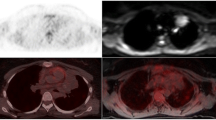Abstract
Background
We hypothesized that F-18 FDG-PET could be a useful, functional imaging modality for assessing the initial staging, response to therapy and follow-up of children diagnosed with lymphoma.
Objective
To assess the role of whole-body F-18 FDG-PET imaging in patients with lymphoma as an initial staging modality and to measure its predictive value for monitoring the response to therapy and disease recurrence compared to CT and clinical follow-up studies.
Materials and methods
As part of their routine clinical care, 24 patients with histologically proven lymphoma (18 Hodgkin disease and 6 non-Hodgkin lymphoma) underwent an F-18 FDG-PET and a CT scan. A total of 28 studies were performed and the entire set of scans retrospectively reviewed. Seven studies were performed for initial staging, 12 for monitoring therapy response and 9 for detecting recurrence. Initial diagnosis was confirmed by histopathology while the gold standard at follow-up was established by clinical follow-up, additional imaging modalities and/or biopsy. F-18 FDG-PET was visually compared to CT on a lesion-by-lesion basis. Fifteen anatomic regions (seven nodal and eight extranodal) were analyzed.
Results
Of the 414 regions analyzed, PET and CT were concordant in 366 (positive in 16 and negative in 350). Discordance was found in 48 regions. Overall sensitivities, specificities, and positive and negative predictive values were 78%, 98%, 94% and 90% for F-18 FDG-PET and 79%, 88%, 90% and 46% for CT, respectively.
Conclusion
F-18 FDG-PET imaging is a useful technique for the staging and follow-up of pediatric patients with lymphoma.





Similar content being viewed by others
References
Magnani C, Gatta G, Coriazzari I, et al (2001) Childhood malignancies in the EUROCARE study: the database and the methods of survival analysis. Eur J Cancer 37:678–686
Hudson MM, Donaldson SS (1997) Hodgkin’s disease. Pediatr Clin North Am 44:891–906
Sandlund JT, Downing JR, Crist WM (1996) Non-Hodgkin’s lymphoma in childhood. N Engl J Med 334:1238–1248
Edwards BK, Brown ML, Wingo PA, et al (2005) Annual report to the nation on the status of cancer, 1975–2002, featuring population-based trends in cancer treatment. J Natl Cancer Inst 97:1407–1427
Brousse N, Vasiliu V, Michon J (2004) Pediatric non-Hodgkin lymphomas. Ann Pathol 24:574–586
Thomson AB, Wallace WH (2002) Treatment of paediatric Hodgkin’s disease: a balance of risks. Eur J Cancer 38:468–477
Pinkerton CR (1999) The continuing challenge of treatment for non-Hodgkin’s lymphoma in children. Br J Haematol 107:220–234
Reske SN (2003) PET and restaging of malignant lymphoma including residual masses and relapse. Eur J Nucl Med Mol Imaging 30:S89–S96
Schiepers C, Filmont FE, Czernin J (2003) PET for staging of Hodgkin’s disease and non-Hodgkin’s lymphoma. Eur J Nucl Med Mol Imaging 30:S82–S88
Schoder H, Larson SM, Yeung HW (2004) PET/CT in oncology: integration into clinical management of lymphoma, melanoma, and gastrointestinal malignancies. J Nucl Med 45:72S–81S
Kumar R, Xiu Y, Potenta S, et al (2004) 18F-FDG PET for evaluation of the treatment response in patients with gastrointestinal tract lymphomas. J Nucl Med 45:1796–1803
Elstrom R, Guan L, Baker G, et al (2003) Utility of FDG-PET scanning in lymphoma by WHO classification. Blood 101:3875–3876
Depas G, De Barsy C, Jerusalem G, et al (2005) 18F-FDG PET in children with lymphomas. Eur J Nucl Med Mol Imaging 32:31–38
Hermann S, Wormanns D, Pixberg M, et al (2005) Staging in childhood lymphoma: differences between FDG-PET and CT. Nuklearmedizin 44:1–7
Munker R, Glass J, Griffeth LK, et al (2004) Contribution of PET imaging to the initial staging and prognosis of patients with Hodgkin’s disease. Ann Oncol 15:1699–1704
Zinzani PL, Fanti S, Battista G, et al (2004) Predictive role of positron emission tomography (PET) in the outcome of lymphoma patients. Br J Cancer 91:850–854
Brenot-Rossi I, Bouabdallah R, Di Stefano D, et al (2001) Hodgkin’s disease: prognostic role of gallium scintigraphy after chemotherapy. Eur J Nucl Med 28:1482–1488
Front D, Bar-Shalom R, Mor M, et al (2000) Aggressive non-Hodgkin lymphoma: early prediction of outcome with 67Ga scintigraphy. Radiology 214:253–257
Rini JN, Nunez R, Nichols R, et al (2005) Coincidence-detection FDG-PET versus gallium in children and young adults with newly diagnosed Hodgkin’s disease. Pediatr Radiol 35:169–178
Kaste SC, Howard SC, McCarville EB, et al (2005) 18F-FDG-avid sites mimicking active disease in pediatric Hodgkin’s. Pediatr Radiol 35:141–154
Weinblatt ME, Zanzi I, Belakhlef A, et al (1997) False-positive FDG-PET imaging of the thymus of a child with Hodgkin’s disease. J Nucl Med 38:888–890
Bangerter M, Moog F, Buchmann I, et al (1998) Whole-body 2-[18F]-fluoro-2-deoxy-D-glucose positron emission tomography (FDG-PET) for accurate staging of Hodgkin’s disease. Ann Oncol 9:1117–1122
Wickmann L, Luders H, Dorffel W (2003) 18-FDG-PET-findings in children and adolescents with Hodgkin’s disease: retrospective evaluation of the correlation to other imaging procedures in initial staging and to the predictive value of follow-up examinations. Klin Padiatr 215:146–150
Pinkerton R (2005) Continuing challenges in childhood non-Hodgkin’s lymphoma. Br J Haematol 130:480–488
Weihrauch MR, Re D, Scheidhauer K, et al (2001) Thoracic positron emission tomography using 18F-fluorodeoxyglucose for the evaluation of residual mediastinal Hodgkin disease. Blood 98:2930–2934
Montravers F, McNamara D, Landman-Parker J, et al (2002) [(18)F]FDG in childhood lymphoma: clinical utility and impact on management. Eur J Nucl Med Mol Imaging 29:1155–1165
Kostakoglu L, Goldsmith SJ (2000) Fluorine-18 fluorodeoxyglucose positron emission tomography in the staging and follow-up of lymphoma: is it time to shift gears? Eur J Nucl Med 27:1564–1578
Moog F, Bangerter M, Diederichs CG, et al (1998) Extranodal malignant lymphoma: detection with FDG PET versus CT. Radiology 206:475–481
Spaepen K, Stroobants S, Dupont P, et al (2001) Can positron emission tomography with [(18)F]-fluorodeoxyglucose after first-line treatment distinguish Hodgkin’s disease patients who need additional therapy from others in whom additional therapy would mean avoidable toxicity? Br J Haematol 115:272–278
Author information
Authors and Affiliations
Corresponding author
Rights and permissions
About this article
Cite this article
Hernandez-Pampaloni, M., Takalkar, A., Yu, J.Q. et al. F-18 FDG-PET imaging and correlation with CT in staging and follow-up of pediatric lymphomas. Pediatr Radiol 36, 524–531 (2006). https://doi.org/10.1007/s00247-006-0152-z
Received:
Revised:
Accepted:
Published:
Issue Date:
DOI: https://doi.org/10.1007/s00247-006-0152-z




